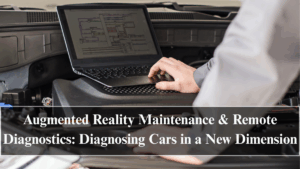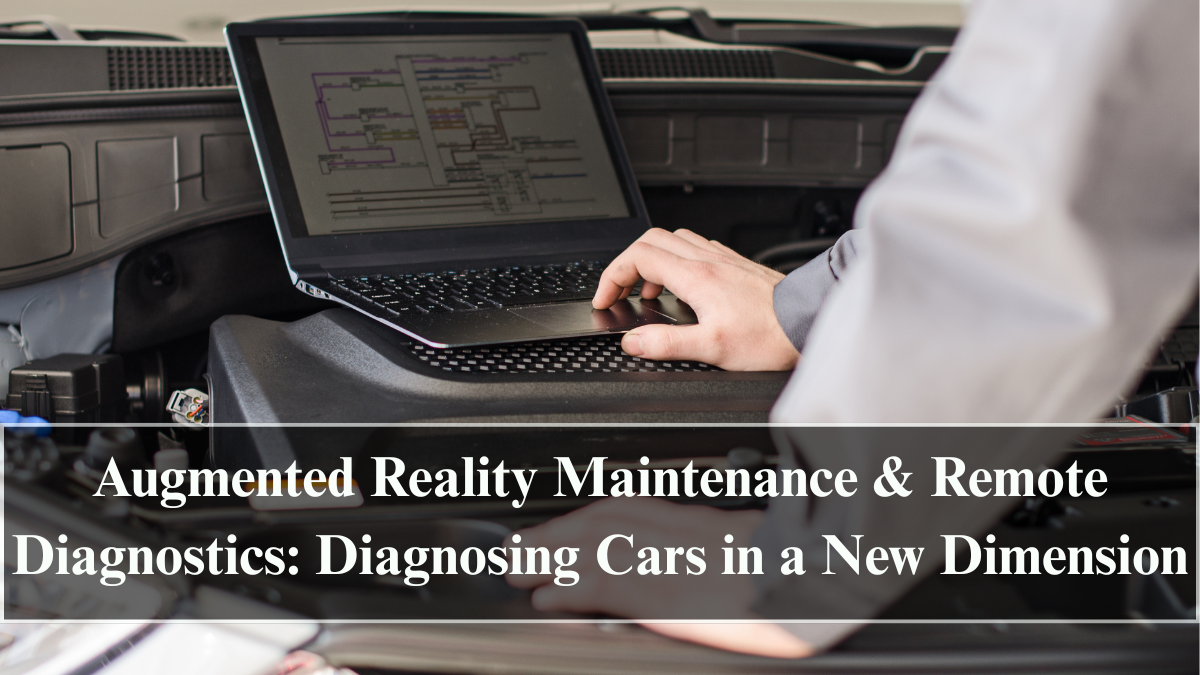In 2025, automotive repair and diagnostics have entered a new era where the physical and digital worlds merge seamlessly. With the rise of Augmented Reality (AR) Maintenance & Remote Diagnostics, technicians and even everyday drivers can now visualize complex vehicle systems in real-time through interactive digital overlays. This innovation is revolutionizing how vehicles are inspected, repaired, and maintained—bringing faster, safer, and more precise service to both workshops and driveways.
Imagine a scenario where a mechanic doesn’t need to dismantle a vehicle to identify an issue. Instead, using AR glasses or mobile devices, they can view a 3D holographic projection of the engine, highlighting malfunctioning components, suggesting repair steps, and even displaying live sensor data. Similarly, car owners can use AR-guided apps to perform basic maintenance like oil changes, fluid checks, or fuse replacements without technical expertise.

The Technology Powering AR Vehicle Maintenance
Augmented Reality Maintenance & Remote Diagnostics 2025 relies on the convergence of several advanced technologies:
-
3D Visualization Engines: Display interactive holograms of vehicle components with real-time motion tracking.
-
IoT and Telematics Integration: Gather live data from vehicle sensors and transmit it to diagnostic platforms.
-
AI-Powered Fault Detection: Analyze data patterns to identify faults faster and more accurately than human inspection.
-
Edge Computing: Process sensor information locally, ensuring immediate feedback without network delays.
-
Cloud-Based Collaboration: Allow experts worldwide to join remote repair sessions through connected AR interfaces.
By combining these innovations, AR systems can display visual cues directly on the car’s surface—such as highlighting a malfunctioning sensor, pointing to the exact location of a leak, or providing torque specifications for tightening bolts.
Remote Diagnostics: Repair Without Boundaries
One of the most transformative aspects of AR maintenance is remote diagnostics. Through live AR video sessions, manufacturers, dealerships, or specialized engineers can connect directly to vehicles anywhere in the world. They can remotely view the issue through the technician’s camera feed, mark instructions in real time, or display step-by-step holographic guidance within the technician’s field of vision.
This capability eliminates geographical limitations—reducing the need for physical workshops in remote locations. For fleet operators, it minimizes downtime by enabling faster intervention, while for consumers, it means fewer service visits and shorter repair cycles.
Companies like Bosch, Hyundai, and BMW are already deploying remote AR diagnostic tools in 2025. Bosch’s “Common Augmented Reality Platform” enables seamless remote assistance for service partners, while Hyundai’s AR service manuals allow technicians to visualize and repair electric vehicles faster than ever before.
The Benefits of AR-Enabled Maintenance
The automotive industry is embracing AR diagnostics not only for speed but also for its wide-ranging benefits:
-
Reduced Downtime: Faster identification and repair of faults minimize vehicle downtime for fleets and consumers.
-
Cost Efficiency: Fewer unnecessary part replacements and reduced technician travel save significant costs.
-
Enhanced Accuracy: Real-time data overlays ensure precise fault identification and standardized repair quality.
-
Training & Skill Development: AR acts as a virtual tutor, guiding new technicians through complex procedures interactively.
-
Customer Empowerment: Vehicle owners gain access to guided maintenance tutorials through AR mobile apps.
In the long term, AR service platforms will integrate with AI-based predictive maintenance systems, allowing vehicles to self-diagnose and even book service appointments automatically.
Challenges and Industry Adaptation
Despite its promise, AR Maintenance & Remote Diagnostics 2025 still faces several hurdles. The cost of deploying AR hardware such as smart glasses, ensuring compatibility across multiple car models, and maintaining data security are top concerns for service providers.
Data privacy is especially crucial, as AR systems access sensitive vehicle and user data. Manufacturers are now implementing end-to-end encryption and secure cloud frameworks to protect proprietary diagnostics and driver information. Additionally, service technicians require new skill sets—combining mechanical expertise with digital fluency in AR tools and interfaces.
The Future of AR in Automotive Servicing
By 2030, experts predict that nearly 70% of global vehicle maintenance operations will incorporate AR-based diagnostic tools. Future vehicles will come equipped with self-reporting AR interfaces, capable of visually showing users the exact problem on their dashboard or windshield through holographic indicators.
The combination of AI, AR, and IoT will make vehicles more self-sufficient, capable of detecting issues, explaining solutions, and even ordering parts autonomously. The evolution of remote diagnostics will also merge with autonomous maintenance robots, allowing automated systems to perform mechanical tasks under expert AR supervision.
Augmented Reality Maintenance & Remote Diagnostics 2025 is not just a technological leap—it’s a transformation in how humans and machines communicate. What was once an intricate, tool-based process is now an immersive digital experience powered by intelligence, visualization, and precision.
FAQs
What is augmented reality vehicle maintenance?
It’s a system where AR technology overlays 3D digital visuals on real-world vehicles to guide repairs, diagnostics, and maintenance in real time.
How does remote diagnostics work in 2025?
Technicians and manufacturers can connect remotely through AR feeds to inspect vehicles, mark issues, and guide repairs from anywhere in the world.
What benefits does AR bring to automotive repair?
It improves accuracy, reduces downtime, lowers costs, and enhances training by providing interactive, visual repair guidance.
Is AR vehicle maintenance secure?
Yes. Data is encrypted, and cloud frameworks follow strict automotive cybersecurity standards to protect user and vehicle data.
What’s next for AR in vehicle servicing?
By 2030, most maintenance will be AR-assisted, with AI predicting faults and vehicles guiding users through self-repair using holographic instructions.
Click here to know more.
